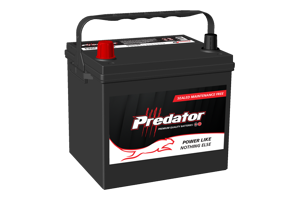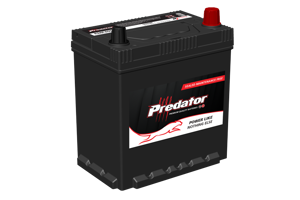Battery 101: Deep Cycle Battery Guide
What is a deep cycle battery?
A deep cycle battery is a type of rechargeable battery which is designed to provide a steady and consistent flow of power over an extended period of time. This makes them particularly useful for applications such as electric vehicles, boats and other devices that require energy over a longer period of time.
Unlike starting batteries, which are designed to deliver a short burst of power and then be recharged, deep cycle batteries are built to withstand repeated deep discharges and recharges. This means that they can be repeatedly discharged to a much lower level (approximately 50%) and then be recharged without losing their capacity.
There are different types of deep cycle batteries in the market such as:
- Flooded
- Gel
- AGM (Absorbent Glass Mat)
- Lithium (e.g. LiFePO4)

Flooded Batteries
Flooded lead acid batteries are a type of deep cycle battery that have been in use for many years. They are made up of lead plates, a sulphuric acid and water electrolyte, and a plastic case. These batteries are called "flooded" because the electrolyte is liquid and fills the battery case, covering the lead plates.
Flooded lead acid batteries are widely used in applications that require a deep cycle battery such as in boats, RVs and off-grid solar power systems. They are also commonly used in backup power systems as they can provide reliable power over an extended period of time.
One of the advantages of flooded lead acid batteries is that they are relatively inexpensive compared to other types of deep cycle batteries. They also have a reasonable lifespan and are easy to charge. Flooded lead acid batteries can also support high discharge rates which make them ideal for applications that require a burst of high energy in a short amount of time. You should, however, always refer to the product data sheet to ensure your application is within the capabilities of the battery.
There are also some disadvantages to using flooded lead acid batteries. One of the main drawbacks is that they require regular maintenance such as topping up with distilled water. They need to be installed and used in a well-ventilated area as they can produce hydrogen gas during charging, which is highly flammable and can be dangerous in enclosed spaces. Flooded lead acid batteries should not be charged at high rates as this will shorten their service life – between 5% and 10% of their rated capacity is an ideal charge rate.
Despite these drawbacks, flooded lead acid batteries remain a popular choice for many applications as they provide reliable and cost-effective power over an extended period of time.
Gel Batteries
Gel batteries are a type of lead acid battery that are similar to flooded lead acid batteries but with a key difference in their construction. Instead of using liquid electrolyte, gel batteries use a gel that is suspended between the lead plates in the battery. This is created by mixing the electrolyte with silica, which thickens it and makes it into a gel.
One of the main advantages of gel batteries is that they are sealed, which means that they do not require lead acid topping up liked flooded lead acid batteries. They are sometimes referred to as VRLA (Valve Regulated Lead Acid) as they are fitted with a one way valve which will release any build up in pressure inside the battery case but will not allow and fresh air into the cell. They also do not produce hydrogen gas during normal charging, which makes them safer to use. However, they still need to be installed in a space with adequate ventilation. In addition, gel batteries are highly resistant to vibration and shock, which makes them ideal for use in rough conditions. Gel batteries have a longer lifespan compared to flooded lead acid batteries, which can make them a more cost-effective option over the long run.
There are also some disadvantages to gel batteries. One of the main drawbacks is that they are more expensive than flooded lead acid batteries, which can make them less attractive for some applications. Additionally, gel batteries cannot support high charging and discharging currents, which means that they can take longer to charge and are generally used in lower discharge applications.
Despite these drawbacks, gel batteries are still a popular choice for many applications that require a deep cycle battery. Their sealed construction and resistance to vibration and shock make them ideal for use in off grid solar power systems, as well as in applications such as backup power systems, RVs, and boats.
AGM Deep Cycle Batteries
AGM (Absorbent Glass Mat) batteries are another type of VRLA battery which uses a fibreglass mat to suspend the electrolyte in place against the plates. AGM batteries are also maintenance free as they do not suffer from water loss during normal operation and do not therefore require the electrolyte to be topped up.
One of the main advantages of AGM deep cycle batteries is their ability to deliver high currents, which makes them ideal for applications that require a lot of power in a short amount of time. They are also highly resistant to vibration and shock, which makes them ideal for use in high vibration conditions.
Another advantage of AGM deep cycle batteries is their fast charging capability. They can be charged at higher current levels however for the longest service life a charge rate of between 5% and 10% of the battery capacity is recommended Additionally, they have a longer service life when compared to flooded batteries.
AGM deep cycle batteries are often used in applications that involve regular deep cycles, such as off grid solar power systems, backup power systems, and auxiliary power in recreational vehicles. They are also commonly used in marine applications, such as in boats and yachts where their resistance to vibration and shock make them a good choice.
One of the main drawbacks of AGM deep cycle batteries is that they are more expensive than flooded batteries. Additionally, they are less tolerant of high temperatures than some other types of deep cycle batteries, which can limit their use in some applications.
Despite these drawbacks, AGM deep cycle batteries remain a popular choice for many applications that require a high performance, maintenance free battery. Their ability to deliver high currents, fast charging capability, resistance to vibration and their extended service life make them ideal for use in a variety of applications where reliability and performance are essential.
Deep Cycle Battery Applications
Deep cycle batteries are used in a wide range of applications where reliable, long-lasting power is needed. Here are some of the most common applications for deep cycle batteries:
Off grid solar power systems:
Deep cycle batteries are used in off grid power systems to store energy generated by solar panels during the day. This energy can then be used at night or during times when the solar panels are not generating enough energy.
Backup power systems:
Deep cycle batteries are used in backup power systems to provide power during power outages. They can be used to power critical appliances and electronics such as refrigerators, lights, and medical equipment.
Marine and RV applications:
Deep cycle batteries are commonly used in marine and RV applications to provide power for lights, appliances, and other electronics.
Golf carts and electric vehicles:
Deep cycle batteries are used to power golf carts and other electric vehicles. They are ideal for these applications because they can deliver the power required and are designed to withstand frequent deep discharges.
Renewable energy storage:
Deep cycle batteries can be used to store energy generated by wind turbines, hydroelectric generators, and other renewable energy sources. This stored energy can then be used when the renewable energy source is not generating enough power.
Industrial applications:
Deep cycle batteries are used in a wide range of industrial applications, such as forklifts, floor scrubbers, backup power systems for data centers, and in remote monitoring and control systems.
Deep cycle battery maintenance
Proper maintenance is key to ensuring the longevity and optimal performance of a deep cycle battery. Here are some important maintenance tips to keep in mind:
1. Regularly check and clean the battery Dust and debris can accumulate on the surface of the battery, which can lead to a short circuit or reduce the battery's performance. To avoid this, it is important to regularly check the battery for any signs of dirt or debris and clean it with a soft, dry cloth or brush.
2. Check the water level in flooded batteries Flooded lead acid batteries require regular maintenance to ensure that the water level is maintained at the proper level. It's important to check the water level in the battery every three to four months, and add distilled water as needed. Overfilling the battery can cause the electrolyte to overflow, which can lead to corrosion and a loss of performance.
3. Use the right charger Using the wrong charger can lead to under or overcharging, which can cause damage to the battery or reduce its lifespan. It's important to use a charger that is designed for the specific type of battery you have and that has the correct voltage and current output.
4. Charge the battery regularly Leaving a deep cycle lead acid battery discharged for an extended period of time will reduce its performance and lifespan. It's important to charge the battery regularly, even if it's not being used. Multistage charges have a float stage which allows the charger to be constantly connected to the battery to maintain it’s State of Charge.
5. Store the battery properly. If you're not going to be using the battery for an extended period of time, it's important to store it properly. Deep cycle batteries should be stored in a cool, dry place, and should be fully charged before storage. It's also a good idea to recharge the battery periodically during storage to maintain its performance.
Deep Cycle Battery Safety and Hazards
While deep cycle batteries are generally safe to use, there are some potential hazards to keep in mind. Here are some of the main safety concerns related to deep cycle batteries:
1. Explosion
Deep cycle batteries contain sulphuric acid , which is a highly corrosive substance that can cause severe damage to skin and eyes if it comes into contact with them. Additionally, overcharging a battery or using the wrong charger can cause it to overheat and potentially explode. To avoid this, it's important to always use the correct charger and ensure the battery is in a well vented area to prevent the accumulation of explosive gases.
2. Acid leakage
If a deep cycle battery is damaged or cracked, it can leak acid, which can be dangerous if it comes into contact with skin or eyes. To avoid this, always handle the battery with care and inspect it regularly for any signs of damage.
To minimize the risk of these hazards, it is important to follow the manufacturer's guidelines for handling and using deep cycle batteries, and to wear appropriate safety gear when working with them. Additionally, it's important to store the batteries in a well-ventilated area, away from sources of heat and open flames. In the event of a battery malfunction or accident, it's important to have a plan in place for proper disposal and clean-up to minimize the risk of harm to people or the environment.
Conclusion
Whether you are using a deep cycle battery for your RV, boat, off-grid cabin or backup power system, taking the time to properly maintain and care for it can make all the difference in its performance and longevity. So, be sure to follow the manufacturer's instructions and keep these maintenance and safety tips in mind to ensure that your deep cycle battery continues to provide reliable power for years to come.



